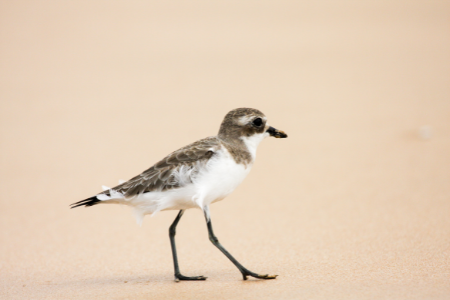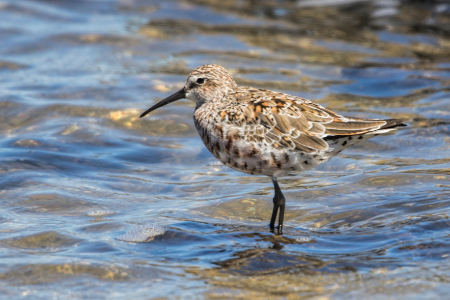Shorebirds

Every spring and summer hundreds of migratory shorebirds gather around the Noosa River mouth to feed and rest. They have flown thousands of kilometres to arrive on Australian shores after leaving their breeding grounds in the Northern Hemisphere.
Here migrant birds are joined by Noosa’s resident shorebirds. Together they create wondrously-biodiverse flocks of birds at the river mouth for all to enjoy.
Shorebird populations are declining worldwide due to habitat loss and human disturbance. This trend is also true for Noosa.
Help us protect these remarkable birds and the habitats they use.
Map of shorebird habitats in Noosa
Fast facts about Noosa’s shorebirds
- Shorebirds lives are driven by the tides regardless of day or night, they forage for food on the low tide and roost on the high tide.
- Twenty-seven (27) species of shorebirds are found around the Noosa Estuary and North Shore.
- Eighteen (18) species are migratory whilst nine (9) species are resident.
- Migratory shorebird arrivals peak in October to November.
- Migratory shorebird departures peak in March to April.
- Some migratory species ‘overwinter’ in Noosa meaning they remain in the estuary year round.
- Habitat loss and human disturbance are the greatest threats to shorebird populations world-wide.
- In Noosa, eight (8) shorebird species are listed as ‘threatened’ under Australian legislation including three (3) ‘critically endangered’ species.
Disturbances you can help reduce
Protecting habitats and reducing human disturbance are key to conserving shorebird populations.
Any action that interrupts the breeding, feeding or resting of shorebirds is classified as a disturbance.
Causing a shorebird to take flight represents a ‘significant’ disturbance. This wastes vital energy and can reduce a shorebird’s survival prospects especially at critical times such as nesting, rearing young or pre and post migrations.
How can you help protect shorebirds?
On the Noosa North Shore, a Restricted Area near the river mouth helps protect important nesting habitat for resident shorebirds. The restrictions prohibit:
- Driving a vehicle into or on the restricted area.
- Allowing a dog into or on the restricted area.
- Riding or leading a horse or another animal into or on the restricted area.
The Restricted Area [JM2] is patrolled by both Council and the Queensland Parks and Wildlife Service. On the spot fines may apply.
You can still walk into this area or access it by boat.
- Observe shorebirds quietly from a distance.
- Keep dogs from chasing or distressing shorebirds.
- Comply with the Restricted Area prohibitions on the Noosa North Shore.
Arriving by boat
Boating with your canine friends around the estuary is a pleasurable experience in itself, however please remember the islands and sandbanks are important foraging and roosting habitats for shorebirds.
Research has shown the presence of off-leash dogs can reduce the number of foraging shorebirds present in a location by 20%. Dogs on a leash, and people alone without dogs, does not appear to have a strong impact on shorebirds (Fuller et al, 2019).
Monitoring and Research
An analysis of migratory and resident shorebird diversity and abundance in the Noosa River estuary 2005-2019 is the first known longitudinal survey of shorebirds in Noosa. It was undertaken by the Shorebird Study Group (Noosa Integrated Catchment Association, Tewantin).
Frequently Asked Questions
-
Most migrant species breed in places in Siberia, Mongolia, northern China and Alaska where the melting snow signals masses of insects which provide a vital food source for their self-feeding chicks. When breeding is complete and before the onset of the Arctic winter, the adults and newly fledged chicks begin their migration to feeding grounds in the south.
In Noosa, migratory arrivals peak in October – November, whilst departures peak in March – April.
-
Shorebirds travel along routes called flyways. Noosa’s migratory shorebirds use the East Asian-Australasian Flyway.
Flyways are like chains where each link is an important wetland like an estuary or bay, where birds can stop to feed and regain their energy for the next stage of their journey.
Some species migrate around 25,000 km annually or fly more than 6,000 km non-stop. They navigate using celestial cues from the sun and stars, the earth’s magnetic field, mental maps and favourable weather patterns when they can. The journey may take several weeks.
The Eastern Curlew is one of the best studied migratory shorebird species, dramatically builds up its body weight just before migration. It will burn off 40 % of this weight to fuel its 13,000 km journey during its flight from Siberia to Australia. The Eastern Curlew is listed as critically endangered and has been observed in Noosa.
-
Shorebirds and Terns both belong to the order Charadriilformes.

Shorebirds are often called ‘waders’. They gather around intertidal areas and freshwater wetlands, have long legs in relation to their body size and specialised bills for pecking and probing worms, insects and crustaceans. Day or night, shorebirds feed on the low tide and rest on the high tide. They do not have web feet and cannot swim.
Terns mainly feed during the day and rest at night. They have a strong association with the sea, have web feet and can swim. Terns feed by hovering and either plunge-dive or pick food items from the surface of the water. Ocean-going species return from their fishing trips in need of rest, which makes estuaries and sandbanks just as important as their offshore
 feeding grounds.
feeding grounds.Shorebird and Tern populations include both migratory and resident species, both of which can be seen around the Noosa Estuary.
Related Information
Noosa Bird Trails
Birdlife thrives in our rich diversity of environments in Noosa, from eucalypt woodland and beaches to our wonderful rainforests. Noosa has thirty-three different sites across the shire where visitors and residents can observe a wide variety of our birdlife.








